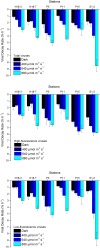Effects of temperature and photosynthetically active radiation on virioplankton decay in the western Pacific Ocean
- PMID: 29367730
- PMCID: PMC5784127
- DOI: 10.1038/s41598-018-19678-3
Effects of temperature and photosynthetically active radiation on virioplankton decay in the western Pacific Ocean
Abstract
In this study, we investigated virioplankton decay rates and their responses to changes in temperature and photosynthetically active radiation (PAR) in the western Pacific Ocean. The mean decay rates for total, high-fluorescence, and low-fluorescence viruses were 1.64 ± 0.21, 2.46 ± 0.43, and 1.57 ± 0.26% h-1, respectively. Higher temperatures and PAR increased viral decay rates, and the increases in the decay rates of low-fluorescence viruses were greater than those of high-fluorescence viruses. Our results revealed that low-fluorescence viruses are more sensitive to warming and increasing PAR than are high-fluorescence viruses, which may be related to differences in their biological characteristics, such as the density of packaged nucleic acid materials. Our study provided experimental evidence for the responses of natural viral communities to changes in global environmental factors (e.g., temperature and solar radiation).
Conflict of interest statement
The authors declare that they have no competing interests.
Figures





Similar articles
-
Virioplankton distribution in the tropical western Pacific Ocean in the vicinity of a seamount.Microbiologyopen. 2020 Jun;9(6):1207-1224. doi: 10.1002/mbo3.1031. Epub 2020 Mar 16. Microbiologyopen. 2020. PMID: 32180355 Free PMC article.
-
Solar radiation-induced mortality of marine pico-phytoplankton in the oligotrophic ocean.Photochem Photobiol. 2007 Jul-Aug;83(4):793-801. doi: 10.1111/j.1751-1097.2007.00144.x. Photochem Photobiol. 2007. PMID: 17645649
-
Kinetics of photosynthetic response to ultraviolet and photosynthetically active radiation in Synechococcus WH8102 (cyanobacteria).Photochem Photobiol. 2014 May-Jun;90(3):522-32. doi: 10.1111/php.12202. Epub 2013 Nov 28. Photochem Photobiol. 2014. PMID: 24175996
-
Interactive Effects of Temperature and UV Radiation on Photosynthesis of Chlorella Strains from Polar, Temperate and Tropical Environments: Differential Impacts on Damage and Repair.PLoS One. 2015 Oct 1;10(10):e0139469. doi: 10.1371/journal.pone.0139469. eCollection 2015. PLoS One. 2015. PMID: 26427046 Free PMC article.
-
Terrestrial ecosystems, increased solar ultraviolet radiation, and interactions with other climate change factors.Photochem Photobiol Sci. 2007 Mar;6(3):252-66. doi: 10.1039/b700019g. Epub 2007 Feb 1. Photochem Photobiol Sci. 2007. PMID: 17344961 Review.
Cited by
-
Reduced bacterial mortality and enhanced viral productivity during sinking in the ocean.ISME J. 2022 Jun;16(6):1668-1675. doi: 10.1038/s41396-022-01224-9. Epub 2022 Apr 1. ISME J. 2022. PMID: 35365738 Free PMC article.
-
Double Maximum Ratios of Viruses to Bacteria in the Water Column: Implications for Different Regulating Mechanisms.Front Microbiol. 2019 Jul 16;10:1593. doi: 10.3389/fmicb.2019.01593. eCollection 2019. Front Microbiol. 2019. PMID: 31379770 Free PMC article.
-
Impacts of Freshwater and Seawater Mixing on the Production and Decay of Virioplankton in a Subtropical Estuary.Microb Ecol. 2019 Nov;78(4):843-854. doi: 10.1007/s00248-019-01362-2. Epub 2019 Apr 10. Microb Ecol. 2019. PMID: 30972435 Free PMC article.
-
Assessment of Explicit Representation of Dynamic Viral Processes in Regional Marine Ecological Models.Viruses. 2022 Jun 30;14(7):1448. doi: 10.3390/v14071448. Viruses. 2022. PMID: 35891428 Free PMC article.
-
Survival of surface bacteriophages and their hosts in in situ deep-sea environments.Microbiol Spectr. 2024 Jan 11;12(1):e0453422. doi: 10.1128/spectrum.04534-22. Epub 2023 Dec 5. Microbiol Spectr. 2024. PMID: 38051228 Free PMC article.
References
-
- Stocker, T. F. et al. Intergovernmental panel on climate change. Climate change 2013: The physical science basis. Contribution of working group I to the fifth assessment report of the intergovernmental panel on climate change. (eds Stocker, T. F. et al.) 953–1028 (Cambridge Univ. Press, Cambridge/New York, 2013).
Publication types
LinkOut - more resources
Full Text Sources
Other Literature Sources

